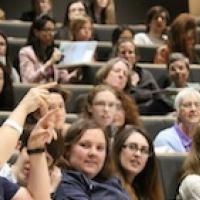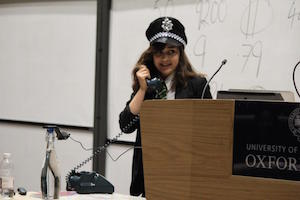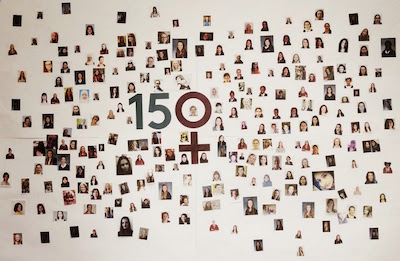
It all adds up

Photo: Jennifer Balakrishnan.
Not many conferences get a standing ovation, but that was what happened at the end of ,It all adds up, the London Mathematical Society's annual Women in Maths conference, last month. It was hosted in the beautiful Andrew Wiles Building at the Mathematical Institute of the University of Oxford. The response was testament to the excellent programme of speakers and activities, but also to what was an unusual experience and atmosphere for many of the audience: "For most of my colleagues, it is completely normal to go to a conference where everyone is the same gender as them," says Julia Gog, a researcher in mathematical biology from the University of Cambridge. "This is not the case for some of us."
In celebration of the 150th anniversary of the London Mathematical Society, the conference was extended from a single day to four days and also welcomed to a much wider audience: inviting secondary students and early undergraduates for the first time.

Some of the hands-on mathematical activities. Photo: Jennifer Balakrishnan.
The first two days were aimed at school students from across the UK, with over 400 students from year 9 to sixth form taking part in master classes and hands-on maths activities and hearing inspiring lectures from across the whole spectrum of mathematics. Julia Gog spoke about her work on the mathematics of infectious diseases to the sixth form students and was particularly impressed by the atmosphere. "The audience did a completely peculiar thing – in that I have never seen it before. Whenever I asked a question there was always no answer for a few seconds, and then whispered answers, and then a collective answer," she said. "There was no one shouting things out too quickly, and everyone waiting to give everyone else time to think." (You can read about Julia Gog's work in the articles Scared of swine flu? Avoid children! and Influenza virus: it's all in the packaging. And you can watch her LMS popular lecture on the same subject.)
Nina Snaith, a mathematician from the University of Bristol, commented on how many students came up to ask questions after her talk. Snaith spoke to the school students about her work on the fascinating connection between the Riemann Hypothesis, an unsolved problem about the distribution of prime numbers, and chaotic quantum systems. (You can find out more in her LMS popular lecture and in an upcoming Plus article – stay tuned!)

One of the audience helps out Hannah Fry in her lecture. Photo: Jennifer Balakrishnan.
And there was no hesitation when the opportunity arose for the audience to get involved themselves, such as in the talk from Hannah Fry, a lecturer in the Mathematics of Cities at University College London. Fry spoke about how maths can reveal the patterns in how we are connected and how these connections can predict how we will behave. (You can hear some of the ideas she talked about in her talk for Ada Lovelace Day at the Royal Institution and in her (longer) presentation I predict a riot!.)
The second two days of the conference were aimed at mathematicians from all stages of their careers, from undergraduates to professors. There were many talks and posters by early career researchers as well as panel discussions on a range of topics including finding funding, career options, and diversity. Caroline Series presented the Senior Anne Bennett Prize lecture, on the early work of Maryam Mirzakhani, the first woman to be awarded the Fields medal in 2014. "Maryam's work and achievement in winning the Fields medal has been such an inspiration to all female mathematicians, I wanted to celebrate it," said Series. (You can read more on Mirzakhani's work in the Plus article Maryam Mirzakhani: counting curves and on the IMU website).

The students wrote questions for the mathematicians to answer later in the conference. Photo: Jennifer Balakrishnan.
Plus was lucky enough to join the conference for the last day, participating in a panel session about careers with maths and enjoying the talks by Nathalie Vriend and Kristin Lauter. Vriend, from the University of Cambridge, spoke about how her research combines mathematical modelling of snow avalanches and the movement of sand dunes with research trips to the Swiss Alps and the Qatari desert. (You can read more about her work in the Cereal, sand and snow and Blown off their feet.)
The conference closed with Kristin Lauter, the Principal Researcher and Research Manager for the Cryptography group at Microsoft Research, talking about one of the great stories of maths in industry and indeed our daily lives: cryptography. Lauter took us on a journey through the history of the hard mathematical problems that have allowed military, industry and now each and everyone one of us using a web browser for online shopping, to keep information secret, and the evolution of attacks to uncover those secrets. Lauter spoke about how cryptography will have to change in the advent of quantum computing, and how mathematics will yet again provide both the tools and the weapons in battle to protect information.

Pictures of women mathematicians from the present and future was built up by participants over the four days of the conference. Photo: Jennifer Balakrishnan.
Vicky Neale, one of the organisers, said that the success of the extended format of the conference (both in time and audience) had lead to the LMS Women in Maths committee exploring the possibility of continuing this larger programme in future years. It seemed clear that continuing to provide such an unusually welcoming event for such a broad range of mathematicians from all stages of their careers has a real benefit, both to the mathematicians of the present and future. "By the time you get to the end of your degree you've pretty much made up your mind what maths is about" says Ceri Fiddes, Head of Maths at Millfield School in Somerset. "By getting in schools and early undergrads you don't close those doors." We agree that it is vital to not only open the door onto the world of mathematics, but also to welcome everyone in.